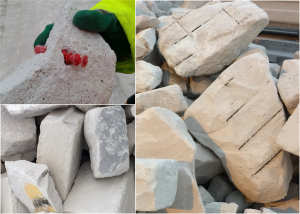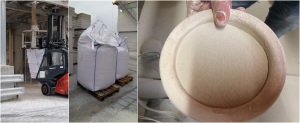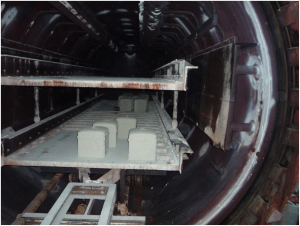REPOST has set itself the goal of creating the basis for a high-quality and economical circular economy of autoclaved aerated concrete (AAC). New and competitive products for masonry constructions are to be created from old AAC. In addition to direct material recycling, alternative recycling methods - e.g. the production of clinker substitutes - are also being investigated. Ecologically and economically viable business models are being developed on the basis of system analyses.

High-quality recycling of AAC
AAC is a building material that has been known and proven for almost 100 years and is also fully recyclable. The recycling of AAC fresh from production, which occurs as cuttings or breakage during production, has been practiced for decades. In contrast, demolished AAC often contains accompanying materials that make high-quality recycling difficult, which is why AAC is usually deposited in landfill after use. Decreasing landfill capacities, legal obligations for the recyclability of products and the protection of primary materials therefore make it essential to find recycling alternatives for to find this demolition material.
REPOST aims at the reduction of primary raw materials in the production of AAC by recycling old AAC at the same or comparable quality level. This concept thus differs from conventional building material recycling. According to statistics, around 90 percent of mineral construction waste was recycled in 2016, but mostly as low-value and one-off down cycling in road construction.

The entire product life cycle at a glance
The REPOST work plan is based on the life cycle of a recycled AAC block and begins with the dismantling and processing of AAC from the existing stock. The central question is which sorting methods are most suitable for obtaining a secondary raw material of the highest possible quality.
The secondary raw material thus obtained is to be used directly as an aggregate for new masonry products. These can be calcium silicate units (CSU) and lightweight concrete blocks or even new AAC blocks.
AAC contains a large proportion of deacidified lime, which was produced with high energy input and high CO2 emissions. Where recycling within a closed cycle is not possible, thermal conversion into dicalcium silicate, a main component of cement clinker, is being investigated. The aim is to partially replace the primary raw materials cement or lime in the production of AAC with a recycled product that causes lower CO2 emissions and energy expenditure during its manufacture.
With the involvement of building owners, demolition companies and processing companies, business models for the new recycling options are being developed over the entire life cycle.

Results (Status June 2022)
At project start, Otto Dörner delivered 25 tons of presorted post-demolition AAC to the Xella granulate plant in Rotenburg/Wümme. After a visual inspection for critical foreign matter the material was subjected to crushing. The resulting AAC-powder was free of pollutants according to LAGA M20, TR Boden, so that from a chemical point of view there were no application restrictions for its utilization.
Since the beginning of the project Otto Dörner Entsorgung GmbH delivered twice approx. 25 tons of presorted post-demolition autoclaved aerated concrete (AAC) to the Xella granulate plant in Rotenburg/Wümme. For this purpose demolition material taken in Hamburg was sorted manually by trained Otto Dörner staff. After a visual inspection for critical foreign matter the material was subjected to crushing at the Xella plant. The resulting AAC-powder was free of pollutants according to LAGA M20, TR Boden, so that from a chemical point of view there were no application restrictions for its utilization.
After optimization of process parameters and formulations, a total of more than 100 kg of belite clinker was fired at the Karlsruhe Institute for Technology, Instutute for Technical Chemistry (KIT-ITC) from four different grades of waste AAC and made available to the project partner Xella. Data on material and energy balances were submitted to Institute for Industrial Production at the KIT (IIP) for techno-economic analysis.
In the small and large-scale pilot plants of the Xella Technologie und Forschungsgesellschaft mbH, recipes AAC and calcium silicate units have been developed that allow the use of large quantities of crushed post-demolition AAC while complying with product properties stipulated by relevant standards and approvals. Currently, test productions based on these new recipes are conducted in Xella plants. The aim is to obtain recipe approvals and to start the production.
The development of AAC recipes containing up to 50 percent belite clinker from post-demolition AAC was successfully completed on a small-scale level. Recipe validations through upscaling in the large-scale pilot plant are in preparation.
By means of modelling, volumes of post-demolition AAC at district level that would accrue by 2050 were determined by KIT-IIP. A techno-economic analysis of all considered recycling options for post-demolition AAC shows that recycling is associated with large CO2 savings as well as significant savings in other environmental impacts. Currently, the modelling of possible AAC circulation systems is investigated.
Applied and basic research
The Hamburg-based company Otto Dörner Entsorgung GmbH will focus on the sorting of old AAC in various quality grades and will provide the project partners with old AAC for the development of recycling products.
The chemists from the Institute of Technical Chemistry (ITC) at the Karlsruhe Institute of Technology (KIT) will adapt the process developed and patented there for the conversion of mineral residues to Belit ("resynergy") for the starting material AAC.
The Institute of Industrial Management and Industrial Production (IIP) of KIT will model the new recycling options in a comparative system analysis. Taking into account the informational, economic, and regulatory framework conditions to be complied with, an assessment is made over the entire life cycle.
Project coordination is carried out by Xella Technologie- und Forschungsgesellschaft mbH, the R&D facility of the AAC and CSU manufacturer Xella. In addition, building material prototypes are developed here on a small and large-scale technical scale and finally transferred to production in selected Xella plants.
Publications
R. Volk, J. J. Steins, P. Stemmermann, & F. Schultmann, F, Comparison of different post-demolition autoclaved aerated concrete (AAC) recycling options. IOP Conference Series: Earth and Environmental Science 2022, 1078, 012074. DOI: 10.1088/1755-1315/1078/1/012074
R. Volk, J. J. Steins, Steins, O. Kreft, & F. Schultmann, Life cycle assessment of post-demolition autoclaved aerated concrete (AAC) recycling options. Resources, Conservation and Recycling 2022, 188, 106716. DOI: https://doi.org/10.1016/j.resconrec.2022.106716
J. J. Steins, R. Volk, F. Schultmann, Modelling and predicting the generation of post-demolition autoclaved aerated concrete (AAC) volumes in Germany until 2050, Resources, Conservation and Recycling 2021, 171, 105504 – 105609. DOI: https://doi.org/10.1016/j.resconrec.2021.105504
A. Ullrich, K. Garbev, B. Bergfeldt, In Situ X-ray Diffraction at High Temperatures: Formation of Ca2SiO4 and Ternesite in Recycled Autoclaved Aerated Concrete, Minerals 2021, 11(8), 789 –811. DOI: https://doi.org/10.3390/min11080789
Den Kreis schließen: Wiederverwertung von Porenbeton (10.09.2020) in German
Article in magazine 320° Magazin (02.04.2020) in German
Project flyer of the funding measure (German / English) (March 2021)
The project flyers offer an insight into the contents and goals of the ReziProK projects and present first results in each case.
Project sheets of the funding measure (German) (August 2019)
The project sheets provide a brief overview of the individual projects and their goals.
Contributions to the ReziProK Transfer Conference in June 2022
Poster (German) (June 2022)
Presentation (German) (June 2022)
Contributions to the ReziProK Kick-off event in December 2019
Poster - in German (December 2019)
Presentation - in German (December 2019)
Picture credits: Dr. Oliver Kreft
